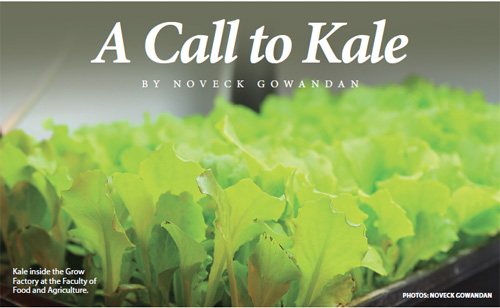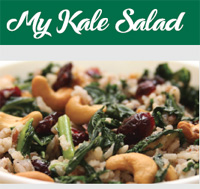|
September 2018

Issue Home >>
|

Today I'm doing a farm-to-table view of Kale, noting some interesting developments on the local front as it pertains to research and development. Kale is not an indigenous plant to Trinidad and Tobago, but you could never tell that by walking into a supermarket and seeing rows upon rows lining the produce aisle. Being mostly imported, the price makes it more of a high-end item, and it's very popular with consumers who can afford to add this perceived superfood to their diet.
Through Dr. Wayne Ganpat, Dean of the Faculty of Food and Agriculture, I was introduced to two students seeking to diversify the diets of Trinbagonians by using scientific methods to grow low-cost, high-yield, consistent and high quality produce that is typically imported.
Nkosi Felix and Jessica Churaman are both research students in Agricultural Economics, and I was fortunate to see their prototype "Grow Factory" in operation. A grow factory is an indoor facility where all environment variables are tightly and precisely controlled – carbon dioxide, light, temperature, nutrients, and moisture – all critical components to help plants grow. The fact that no pesticides or fungicides are used make it a clear winner over open field farming, which is at the mercy of the weather, pests and a large number of other threats.
From Nkosi’s and Jessica's research, grow factories do have a higher start-up cost, but boast lower operational costs, higher yield per square foot, a significantly lower environmental impact, as well as the opportunity to be an automated 24/7 type operation. It can also scale easily from small, backyard type installations to massive indoor farms. The potential is huge for growing produce locally, instead of importing and thus making it affordable for the everyday consumer.
A tour of the research facility revealed a fairly small room, perhaps 10 by 16 feet, maintained at a frigid 17 degrees Celsius with a slight but constant hum from the hydroponic pumps. The grow lights were a brilliant yellow; stepping into the room from a dark corridor felt like walking outside into lustrous sunshine. When my eyes adjusted I saw the vibrant swatches of green; countless seedlings and plants of temperate varieties (that I was asked not to name just yet since they are currently being researched).
The science behind this innovative farming is amazing, but I'm a foodie and was more interested in actually creating something with the bunch of fresh Kale I managed to score. I was able to sample a leaf directly from the equipment; and it was tender with a light crunch, with a distinct sharpness and lingering bitterness, a flavour somewhere between local green plums and fresh celery. The stems were quite bitter and would serve well cooked, or perhaps in your favourite healthy smoothie. I was made to understand that the leaves I was given were a bit on the young side, and would benefit from a raw or semi-raw consumption, whereas the older leaves and stems are better suited for cooking methods such as stir-fried, sautéed or otherwise incorporated into your favourite dishes.
Armed with a basic idea of its complex flavours as well as pro tips from the master farmers/researchers, I decided on a salad. Not necessarily a run-of-the-mill leaves-with-dressing type salad. What immediately came to mind was a warm salad – a flavour-packed concoction of locally grown wholegrain brown rice, kale, cranberry and cashews tied together with some locally produced coconut oil infused with fresh garlic.
The wholegrain brown rice is inherently nutty and has a lovely chewiness. Kale leaves, sans stem, added an earthy complexity with fruity undertones. Cranberries added both sweetness and acidity, but also a pop of vibrant colour. Cashews added a bit of fat to balance the acidity and sharpness, as well as bring some lovely contrasting crunchiness to each bite. The combination of fat and tartness certainly helped mellow out the residual bitterness of the raw kale.
The secret here is timing of the ingredients, folding in the Kale into the hot rice and allowing it to sit while covered for a few minutes, produces a light steaming effect which will tame some of the naturally harsh character of the kale. Then the remainder of the ingredients can be tossed in and served.
Overall this dish is a simple-to-prepare, but paradoxically complex with layers upon layers of texture and flavour.
 The recipe for this dish is below. The recipe for this dish is below.
Inspiration: The Editor of UWI TODAY who knows I can't let a challenge pass by, as well the Dean, Faculty of Food and Agriculture who spared the time for enlightening conversation about agriculture in Trinbago. (Editor’s note: This recipe rocks!)
Ingredients:
- 5-6 cups loosely packed Kale, roughly chopped
- 3/4 cup wholegrain brown rice (yields about 2 1/2 cups cooked)
- 3/4 cup roasted cashews
- 3/4 cup dried sweetened cranberries
- 1 tbsp coconut oil
- 1 clove garlic, finely minced
- salt and black pepper to taste
Prep:
- Add garlic to coconut oil and let sit
- Rinse Kale leaves with gently running water.
- Cut and discard stems (or save for soups, smoothies or stock)
- Roughly chop into about 1 1/2 inch pieces and divide in two
- Cook rice according to instructions (approx 2:1 water to rice ratio in rice cooker)
- In a large mixing bowl with a tight fitting lid, add half the Kale
- Spoon in hot rice and then top with the remaining Kale
- Cover dish and let sit for 7-10 minutes.
- Fold in infused coconut oil, cranberries and cashews.
- Add salt and black pepper to taste.
- Serve immediately.
Serves: 3-4
Estimated Prep Time: ~ 40 minutes
Noveck Gowandan is the eLearning Team Lead at the Campus IT Services Department of the UWI St. Augustine Campus. He is also a food blogger (Tastum Goodum) and foodie. |





